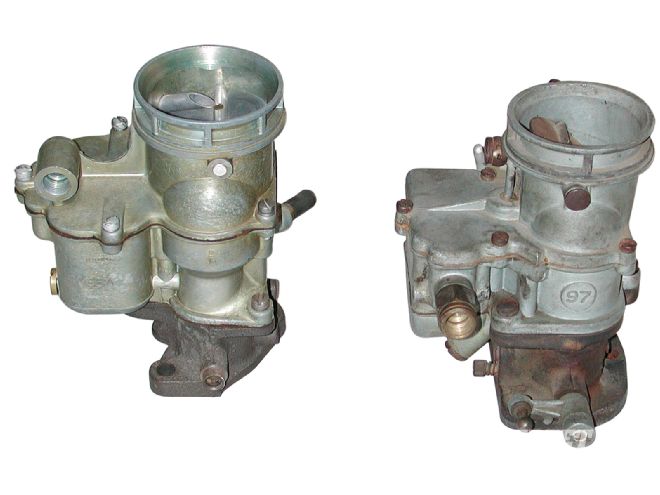
Our hobby is full of contradictions; on one hand it's steeped in tradition, on the other it embraces the latest technology. There are rodders, like Editor Brennan, who love the latest, high-tech components. Brennan's gadget-oriented philosophy is "anything worth doing is worth making as complicated as possible"-if a computer, multiple sensors, and miles of wire is involved controlling any function he's happy. Throw in a couple of blinking LEDs and he's delirious. On the other end of the spectrum are those of us who consider simplicity the ultimate engineering accomplishment, no electronics, no wires, and the only mode is manual. Apparently there are more than a few who appreciate the uncomplicated approach. How else could the selection of brand-new old carburetors be explained?
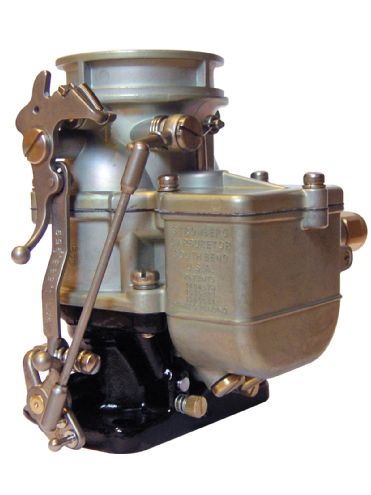 Here's the latest in vintage carburetion: left to right the Stromberg 97, the Holley 94, and the 9Super7.
Here's the latest in vintage carburetion: left to right the Stromberg 97, the Holley 94, and the 9Super7.
Of all the carburetors that have ever been produced, two of the most popular have been the Stromberg 97 and the Holley 94. Today both are being reproduced-Stromberg Carburetors, a British company, offers the 97 and Edelbrock the 94; both are cosmetically identical to the originals with some unseen mechanical improvements. A third offering, the 9Super7 from Speedway Motors is similar in appearance to a Stromberg but will not be mistaken for one by those familiar with an original. Speedway has made several changes to the original design, including manufacturing the base assembly in aluminum rather than cast iron.
All carburetors have the same basic systems: an idle system to deliver fuel below the throttle plates when they are almost completely closed with the air/fuel ratio controlled by needle valves; a main system that delivers fuel to the venturi when the throttle plates open past idle; a transfer system that supplies fuel as the throttle plates open and the carburetor goes from idle system to main; a power system that provides a richer air/fuel ratio when the engine is under load; an accelerator pump to add fuel and prevent stumbling when the throttle is opened suddenly; a float, needle, and seat to control the fuel level in the bowl. Stromberg 97 and Holley 94 carburetors have these systems, but there are subtle differences in how they are configured. Let's take a look at the two designs individually and then compare them.
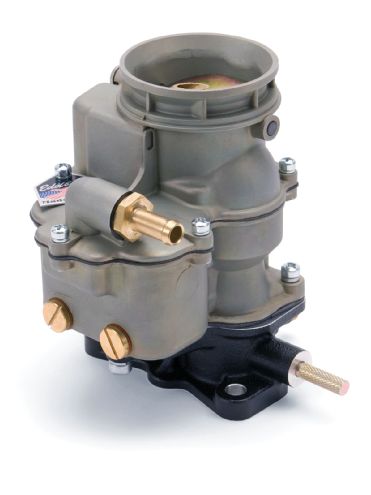
Stromberg produced carburetors for a variety of automobile manufacturers but the versions that most hot rodders are familiar with first appeared as the Model 40 in 1934 on 85hp Ford Flatheads; the model 48 was introduced on V-8s in 1935 (the preceding were both rated at 170 cfm); and from 1936 to early 1938, 97s were installed on Fords (155 cfm). The smaller-model 81s (125 cfm) were used on the V-8/60s while the larger LZs (160 cfm) were found on the Lincoln V-12s. In addition to those factory-installed carburetors, what were known as Type I Stromberg 97s were manufactured by Bendix in South Bend, Indiana, as replacements for Holley 94s; most of these have the 97 logo. Replacement versions, designated the Type II, were manufactured by Bendix in Elmyra, New York, and have a 1-1 logo.
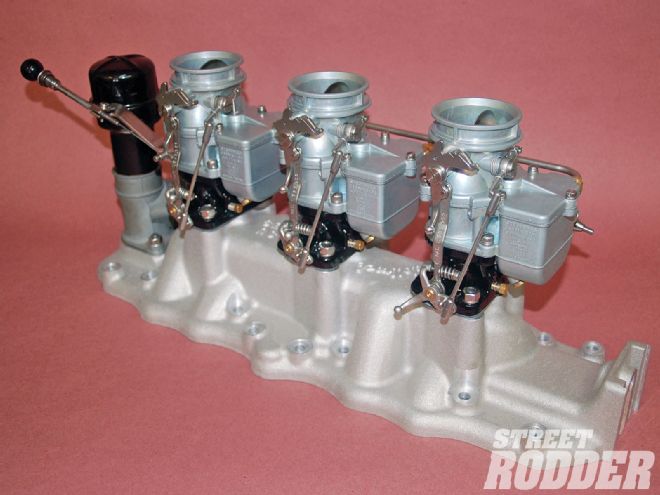 Nothing is cooler than multiple carbs and they can be made to work as great as they look. This classis three-two setup for a Flathead uses Stromberg 97s on an Edelbrock manifold.
Nothing is cooler than multiple carbs and they can be made to work as great as they look. This classis three-two setup for a Flathead uses Stromberg 97s on an Edelbrock manifold.
Holley 94s are often mistaken for Strombergs even though there are some obvious differences. Used as original equipment by Ford from 1938-57 and sold by parts stores as replacement carburetors 94s have always been more plentiful than 97 and as a result less expensive. Like many things that Henry Ford was involved in, the Holley 94 had an interesting beginning.
When Ford was getting ready to release the new 24-stud Flathead he contracted with the Chandler-Groves Company to develop an entirely new, more efficient carburetor and produce them for the 1938 production run. In exchange for that agreement, Ford was granted the patent on the new design and when the year was up he went looking for a better price on carburetors. Holley was able to cut the price by less than 10 cents a piece and became the sole supplier of 94s until production came to a halt in 1957.
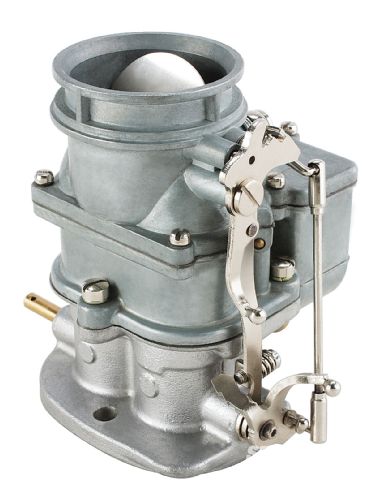
As a result, carburetors produced for Ford in 1938 are labeled Chandler-Groves, those made by Holley may have the Ford script on the float bowl while some later-model versions have a 94 cast into the bowl. There are also replacement carburetors.
Now that new versions of both carburetors are available, the debate over which is better could go on indefinitely. The Holley 94 has two 15/16-inch venturi while those of the Stromberg 97 measure 31/32 inch. It would seem obvious that the slightly larger 97 should flow more, however their numbers are almost identical. Although Stromberg 97s and Holley 94s share the same three-bolt mounting pattern, there are a number of significant differences between the two. The fuel inlet is in the float bowl top of the 94s, rather than the side of the bowl as on the 97s. The 94s use a center-hung float as opposed to the side-hung design of the 97s. Finally, the 94s used spray bars for discharging fuel in the main system, while the 97s used emulsion tubes. All that being said, dyno testing has revealed that there is no significant difference between the two designs. The Stromberg is slightly better at producing horsepower in relation to the fuel consumed at low speeds (below 2,500 rpm) and the Holley is better above that range-but the difference is roughly 1 hp. So, why were 97s more popular than 94s on hot rods? One advantage of the 97 is that when multiple carburetors are used the main jets can often be changed without removing the carburetor from the manifold, not possible with 94s. Of course in a race environment that was important, on a street engine not so much. The other issue with 94s was the enrichment system.
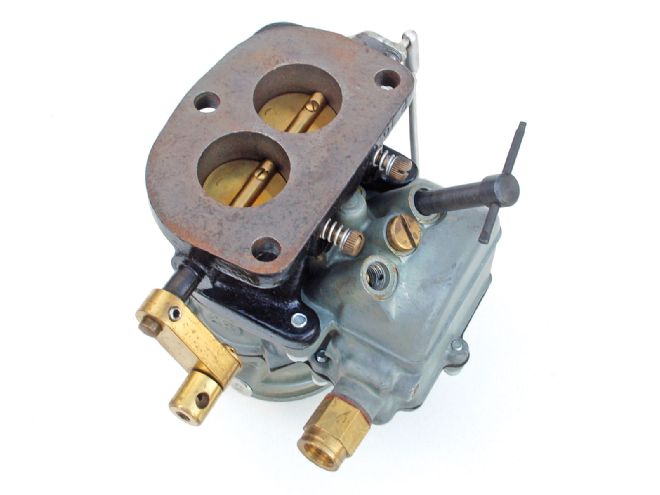 This upside-down view of a Stromberg 97 shows the plugs that are removed to gain access to the main jets-a special wrench is required to remove them. Note the idle mixture screws are on the front side of the base.
This upside-down view of a Stromberg 97 shows the plugs that are removed to gain access to the main jets-a special wrench is required to remove them. Note the idle mixture screws are on the front side of the base.
Strombergs used a mechanically operated power valve that is only activated when the throttle was wide open and the engine can use the extra fuel. Holley's enrichment system used a vacuum-operated power valve that opened to supply extra fuel to the engine when the vacuum dropped to a certain point, usually 7-1/2 inches Hg or less. The problem is that when two or more carburetors are used, the vacuum signal drops earlier and more aggressively than with a single carburetor. As a result, when using multiple carburetors the power valves may open prematurely, making the mixture much richer than necessary. This is easily cured by selecting a power valve that opens at a lower value. Another issue with using multiple 94s is their size. Slightly larger front-to-back than a 97, fitting three 94s on some manifolds can be a problem (a situation some responded to by grinding down the front screw boss on the float bowl).
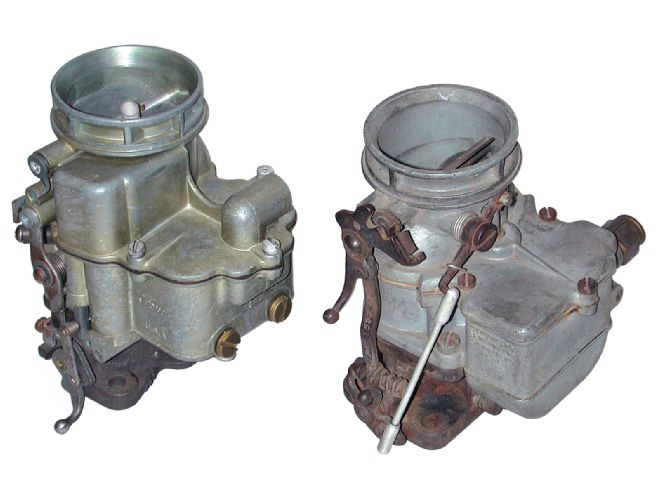 Note the plugs in the float bowl of the 94 (left). They are removed to access the main jets. On the 97 (right) the accelerator pump linkage is external.
Note the plugs in the float bowl of the 94 (left). They are removed to access the main jets. On the 97 (right) the accelerator pump linkage is external.
New Old Carburetors Stromberg Carburetor
Not long after Stromberg Carburetor of England was formed and began producing new 97s and parts there were some conflicts within the management that interrupted manufacturing. The rumor mill was quick to provide all sorts of false information, however we're happy to report that the issues have been resolved and the company is in the capable hands of Clive Prew.
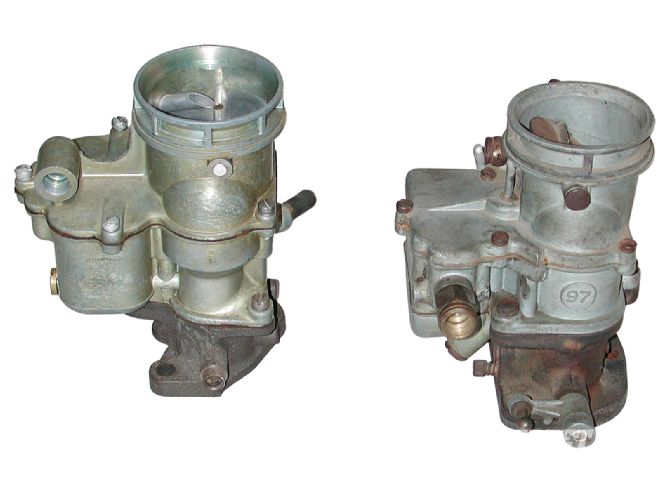 Compare these originals-a Holley 94 on the left and a Stromberg 97 on the right. Note the positions of the fuel inlets.
Compare these originals-a Holley 94 on the left and a Stromberg 97 on the right. Note the positions of the fuel inlets.
According to Prew the new 97 combines the early style cast-iron base with the later Stromberg-style circuits for improved off-idle response, and so there is no mistaking what they are, these carburetors wear a big 97 logo. Like the originals, they come with 0.045-inch main jets and a number 65-power valve. There are a variety of improvements, including a new air horn design with extra material around the float bowl lid to help prevent warping and the leaks that result, and a new, no-stick S-Jet inlet valve. The finish is correct pale lemon chromate with iridescent highlights and the bases have a black Parkerized/lacquered finish. Retail price is around $450.
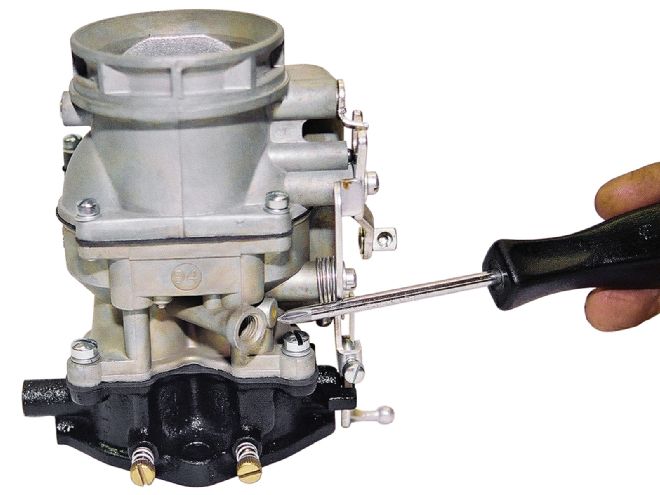 The more you compare the Stromberg and Holley 94, more differences will be found-94s will have the idle screws on the rear of the base. The fitting pointed to was for the vacuum advance used on late Flatheads.
The more you compare the Stromberg and Holley 94, more differences will be found-94s will have the idle screws on the rear of the base. The fitting pointed to was for the vacuum advance used on late Flatheads.
In addition to complete carburetors, Stromberg Carburetor offers individual parts and has recently come out with fuel lines, linkage, and fully chromed carburetors.
Speedway Motors
Described as a 97-style carburetor, is the 9Super7 from Bill Smith's Speedway Motors. Similar in appearance to a Stromberg, the Speedway carburetor lacks the logo and patent numbers found on the originals for obvious reasons. It also has an aluminum base, stamped throttle and choke levers, and the heads of the screws are not like the originals.
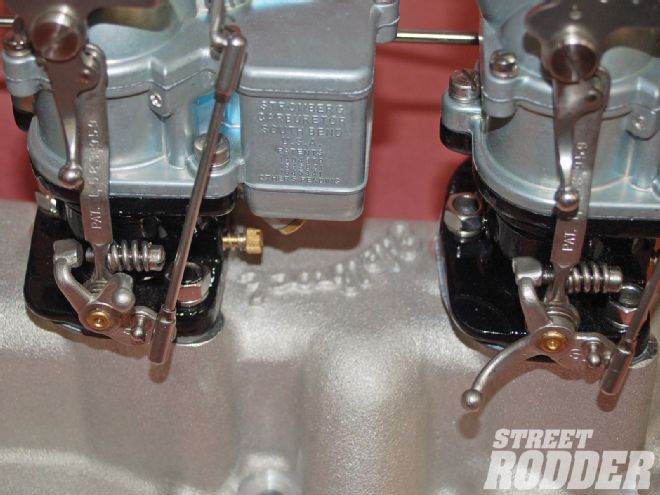 Note difference in these available Stromberg throttle levers-on the left the lever pulls toward the rear to open the throttle valves, on the right it pushes forward. Note the two positions for the accelerator pump rod-they're marked "S" for summer and "W" for winter.
Note difference in these available Stromberg throttle levers-on the left the lever pulls toward the rear to open the throttle valves, on the right it pushes forward. Note the two positions for the accelerator pump rod-they're marked "S" for summer and "W" for winter.
Inside the 9Super7 is a Grose Jet inlet valve to better cope with higher fuel pressure, its said not to stick or dribble and won't corrode in modern fuel. Like the originals, the 9Super7 carbs are shipped with a number 65 power valve and 0.045-inch main jets. Retail price is $299.
Edelbrock 94
The Edelbrock carburetor is a very faithful looking recreation of the Holley 94. It features a die-cast bowl and air horn with an aluminum three-bolt base and comes equipped with an extended throttle shaft to make it easier to set up dual and triple carburetor combinations. For durability and classic looks, these good carburetors are finished off with a zinc-dichromate coating.
One of the issues with the 94 has been finding the proper power valves, contemporary Holley power valves can't be substituted, as they don't seal properly. However Edelbrock now provides a selection of the correct components that makes the new 94 easy to tune.
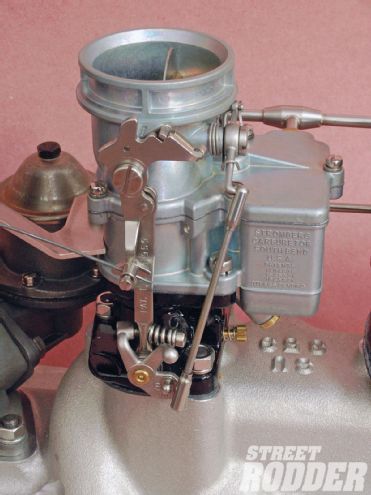 The Stromberg cable choke kicker is a reproduction of the original part offered on Stromberg 97s sold as aftermarket replacements for the '49-53 Fords (which used a cable-type choke).
The Stromberg cable choke kicker is a reproduction of the original part offered on Stromberg 97s sold as aftermarket replacements for the '49-53 Fords (which used a cable-type choke).
Unlike the other offerings, Edelbrock offers two versions of the 94-one, PN 1151, for primary use, the other, PN 1152, is to be used as a secondary. Retail price is $349.99.
So, which one is best? That depends on what you're after. For the ultimate in authentic looks the Stromberg and Holley get the nod, for affordability it's the 9Super7. But regardless which you choose, these are brand-new carburetors and they each can be expected to perform satisfactorily. Of course with multiple carburetors and some engine component combinations rejetting may be required and most likely the power valves in the Edelbrock will have to be optimized, but the end result will be functional simplicity with no wires or blinking LEDs-the latest in low tech.